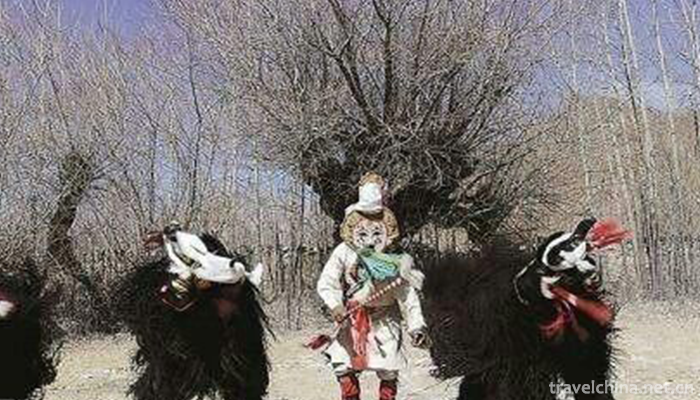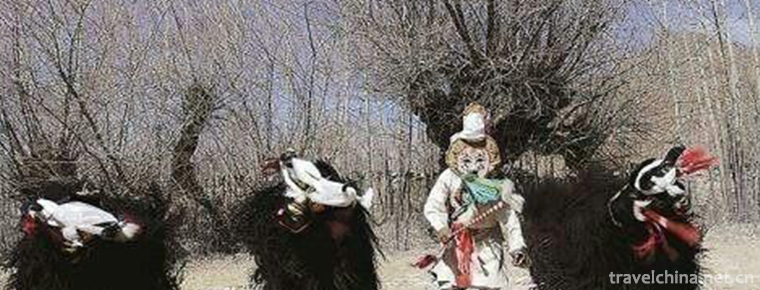Xie Rong Zhongzi
Xie Rong Zhongzi
Xierong Zhongzi still keeps the primitive and simple legacy, from which we can see the spiritual sustenance and aesthetic pursuit of Tibetan ancestors. This kind of primitive culture and art has become the "living fossil" to study the social, cultural and historical development of Tibet.
On May 23, 2011, Xierong Zhongzi was listed in the third batch of national intangible cultural heritage list by the State Council.
Current situation of inheritance
The earth is bright and beautiful in spring, peacocks sing softly and gently, and rainbows of five colors appear in the sky, flowers blossom everywhere... In this auspicious day, according to ancient traditions and customs, two bison from Xierong, together with me, wish a happy and auspicious life. This is the beginning of Xierong Zhongzi. "Ah Ge" is the leader of dance. In the clang of cymbals and drums with strong rhythm, "Ah Ge" and "six steps and one lift" appear. After a circle around the field, they stop in the middle. Then they say the above words rhythmically.
With the development of society, Xierong Zhongzi has been developing and changing in the long history. In response to this situation, Chas, the sixth generation successor of Xierong Zhongzi, said: "In the past, Xierong Zhongzi, a jumper, demanded to be powerful and strong, showing the tough character and characteristics of buffalo. When performing at various celebrations, some organizers demanded cheerfulness and intensity. In this way, there is no bison's character, but also lost its original style and characteristics. We don't like this kind of jumping, and the masses don't like it either."
Stylistic features
Xierong Zhongzi is closely related to Tibetan opera, which can be seen from clothing, props and singing tunes. The clothes worn during the performance of "Zhongzi" are Tibetan clothes, all of which are made of Shu Shu. Tao has Tibetan opera masks on cymbals, drums, Ah Ge's faces and "towers" (colorful flagpoles), cowhides on bulls and cows, and a pair of cow heads. Performers who play bulls and cows wear black clothes to match "cowhide".
Every year on the Shelton Festival, the "Zhongzi" performing team of Xierong Village takes part in Tibetan opera performance in Lhasa. Although the performance time is not too long, it is a necessary performing team. The main reason is that Xierong Zhongzi highlights blessings, auspiciousness and perfection. The "Zhongzi" performance team of Xierong Village not only performs at the village's Wangguo Festival, but also is invited to perform at various celebrations.


-
2.Stewed Pork Ball in Brown Sauce
Lion head is a traditional dish in the Huaiyang cuisine of Yangzhou, Jiangsu, China. Legend has it that Lion's Head began in the Sui Dynasty
Time 2018-10-27 -
3.The Beijing Palace Museum
The Beijing Palace Museum was established on October 10, 1925, and is located in the Forbidden City of the Beijing Palace Museum. Based on the palaces of Ming and Qing dynasties
Time 2018-11-24 -
4.Dongchang Lake Scenic Area
Dongchang Lake Scenic Spot, located in the southwest of Liaocheng City, a famous national historical and cultural city, belongs to Dongchangfu District and is a national AAAA-level tourist scenic spot
Time 2018-12-20 -
5.Guangdong First Peak Tourist Scenic Spot
Guangdong First Peak Tourist Scenic Area is the largest oasis on the Tropic of Cancer. It has a large area of primitive forests, stable forest ecosystem, dense evergreen broad-leaved forests
Time 2019-01-13 -
6.Xiaolangdi Yellow River Three Gorges Scenic Area
The Three Gorges Scenic Area of the Yellow River in Xiaolangdi is a world geological park, a National Water Conservancy Scenic area, the most attractive place in China, ten hot spots in Henan Province
Time 2019-02-25 -
7.Lake Yanxi
Yanqi Lake: located at the foot of Yanshan Mountain 8 kilometers north of Huairou City, a suburb of Beijing, is a land and water area centered on the lake surface
Time 2019-03-02 -
8.Yangshan Ancient Town International Military Tourism Resort
Yangshan Ancient Town International Military Tourism Resort is located in Yangshan Town, Jinxiang County, Southwest Shandong Province. Yangshan Ancient Town International Military Tourist Resort is a
Time 2019-03-02 -
9.Manchu speaking Department
Manchu Folk Talk Department refers to a long prose narrative literature created and preached by Manchu folk artists, which aims to reflect the war life and emotional world of the Manchu people in hist
Time 2019-05-19 -
10.Nuuziz Festival
The word "Nuruzi" comes from the ancient Iranian language and means "spring rainy day". On March 21 of each year, like the Spring Equinox, it means the arrival of spring. Uygur, Ta
Time 2019-06-08 -
11.Tianshi cave
Tianshi cave, also known as Chang Taoist temple, is the most important Taoist temple in Qingcheng Mountain. In 1983, it was designated as the national key Taoist temple by the State Council. In addition, there are four palaces in Qingcheng Mountain: Jianfu palace, Yuanming palace, Yuqing palace and Shangqing palace.
Time 2020-11-08 -
12.Suining history and culture
As a place name, "Suining" began in the Eastern Jin Dynasty. The Eastern Jin Dynasty coexisted with the Sixteen States, while Suining belonged to the Chenghan state. At that time, the rulers of various countries had been fighting with each other for years
Time 2020-12-16